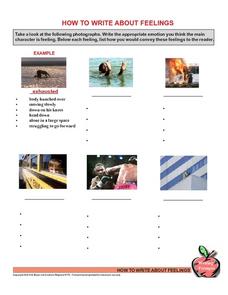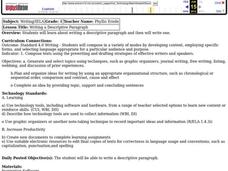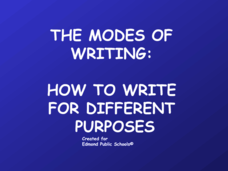Curated OER
Getting to Know You
After going over the five steps of the writing process, pupils fill out "Getting to Know You" worksheets. They trade papers with each other, and have the task of writing a descriptive paragraph about the person whose worksheet they...
Film English
World Builder
If you could build your own world from the ground up, what would you include? Ask your pupils this question, and have them write about their worlds and share with partners. Then, show the short film, which includes some impressive world...
Curated OER
Vivid Verbs
Spice up your writing! Your amateur writers will benefit from concentrating on understanding and improving verb use in writing. An introductory activity addresses weak verbs. A second exercise helps them see the importance of strong...
Curated OER
Beautiful Noise Poetry
"What a beautiful noise comin' up from the street; got a beautiful sound, it's got a beautiful beat..." Use Neil Diamond's "Beautiful Noise" to guide your class through a Six Trait writing activity, in which they write an original poem...
Curated OER
Reading a Classic Novel
Charles Dickens offers an excellent example of sensory writing in this reading comprehension worksheet. Learners read excerpts from the novel Hard Times in which he describes the New England industrial city of Coketown. They consider why...
Curated OER
Similes
Similes are a great way to get your writers thinking about descriptive details. They read a brief explanation which covers clichés and the general wording of a simile. Then, learners try a few on their own. First, they complete nine...
Curated OER
Synonyms
Use this resource to help learners improve the quality of their writing. Discuss the importance of using synonyms for commonly used words. Class members also learn to use a thesaurus, and revise a writing sample to include more...
Curated OER
Lesson: Weaving Words
A woven rug depicting birds and cornstalks becomes the inspiration for a lesson on critical thinking and creative writing. Learners analyze the symbolism found in the rug and then compose a descriptive paragraph or poem that embodies the...
Curated OER
Figurative Language: Part Two
Help your young writers make their writing more descriptive and exciting in this figurative language lesson. Middle schoolers review their figurative language examples from Part One (linked to this lesson), and then write a paragraph for...
Curated OER
Reading a Dialect
Reading a dialect can be difficult; show readers that it can also reveal fascinating details! They read two extracts from Jane Gardam's The Hollow Land, which is written in a British dialect. Readers answer comprehension questions,...
Curated OER
Setting Worksheet
Set your class up for success with writing descriptive settings with these two graphic organizers. On the first page, writers note specifc details about their chosen setting and comment on how each character views the setting. The second...
Curated OER
How to Write About Feelings
This worksheet presents a clever way to help learners practice writing about feelings. In it, six photographs are shown. Below the photos are a line for a feeling word, then some bullet points to write phrases which match what the person...
Curated OER
Showing not telling writing
How do good writers exhibit emotion in their work without using an emotion word (angry, sad, happy, etc.)? This plan offers learners model texts that describe an emotion without using an emotion word. A well-formatted writing activity is...
Scholastic
Quick as a Cricket Lesson Plan
Teaching young learners about similes is easy as pie with this primary grade language arts instructional activity. Following a class reading of the children's book, Quick as a Cricket by Audrey Wood, young readers learn the definition of...
Film English
London
Give your class a tour of London! Before you get started, pupils can brainstorm what they do and do not know about the city and discuss how they think it may have changed over the years. The provided video shows footage from London in...
Curated OER
Lesson: That Long Jakes
Cross-media analysis takes time and attention to detail. The class analyzes the painting Long Jakes and the poem "Backward Bill." They pay attention to the similarities and differences in each piece, looking for details that describe the...
Film English
The Beauty of a Second
Add many seconds of beauty to your class with a short film and related project. The resource centers around a competition based on one-second segments of film, and the final compilation that came from the contest. Pupils identify moments...
Curated OER
Using the Senses to Write Descriptively
Students write descriptive paragraphs using adjectives based on the use of their five senses. They use sensory impressions to improve their writing.
Curated OER
Fear Factor Fun
Students develop "Fear Factor" stunts using descriptive language. In this writing instructional activity, students watch clips from the show "Fear Factor" and develop their own stunts. Students write and explain the stunts in vivid...
Curated OER
Writing Descriptive Paragraphs
Show a Powerpoint presentation about descriptive writing. Fourth graders brainstorm a list of writing topics and place them in graphic organizers. Then they write their own paragraphs describing topics of their choice and create...
Curated OER
Main Idea
What could you pack for a trip if you don't know the destination? After writing a list of items they would want to bring, fourth graders learn that the "trip" is to the South Pole - revealing the need to understand all available...
Curated OER
Lesson Plan 8: Setting and Mood
What mood does this story evoke? How are setting and mood linked? Young novelists explore the different emotions brought about by writing, starting by journaling things that inspire their own feelings. Examine the word mood, looking into...
Curated OER
Easter Egg Surprise
Young readers describe objects by using describing words. After reviewing the five senses, they use their senses to gain information about an object. Then as homework, they write three descriptive words about a mystery object and place...
Edmond Public Schools
The Modes of Writing: How to Write for Different Purposes
Do your pupils know the difference between varying types of writing? This 57-slide presentation is made up of four sections: narrative writing, descriptive writing, expository writing, and persuasive writing. Split it up and use the...
Other popular searches
- Descriptive Writing Samples
- Beach Descriptive Writing
- Descriptive Writing Process
- Descriptive Writing Prompts
- Descriptive Writing Skills
- Descriptive Writing Lessons
- Leads + Descriptive Writing
- Leads Descriptive Writing
- Owl Moon Descriptive Writing
- Writing Descriptive Essay
- Writing a Descriptive Essay
- Descriptive Writing Frame

























